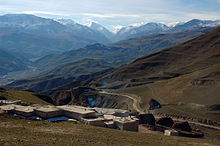Azerbaijan
![]()
The title of this article is ambiguous. For the historical region of Azerbaijan in the far northwest of Iran, see Azerbaijan (Iran).
Template:Infobox State/Maintenance/NAME-German
Azerbaijan (Azerbaijani Azərbaycan, officially Republic of Azerbaijan, Azerbaijani Azərbaycan Respublikası) is a state in the Near East with a population of about 10 million. Located between the Caspian Sea and the Caucasus, it borders Russia to the north, Georgia to the northwest, Iran to the south, Armenia to the west, and Turkey via the exclave of Nakhichevan, which is separated from the Azerbaijani heartland by a strip of Armenian territory. The capital and largest city of Azerbaijan, with a population of about 2.2 million, is Baku (Azerbaijani Bakı), a major port city on the Caspian Sea. Other important cities are Sumgait, Gandja and Lankaran. The total area of the country is 86,600 sq km. More than 89 percent of the population are Shiite Muslims.
"Azerbaijan" originally referred to the Iranian region of Azerbaijan further south, while the present-day territory was called Arrān and Albania. When the Russian Empire collapsed, the independent Democratic Republic of Azerbaijan was proclaimed on May 28, 1918. The Azerbaijan Soviet Socialist Republic was a constituent state of the Soviet Union. It became independent in 1991, the country is ruled authoritarian as before.
Azerbaijan has significant oil reserves. A rapid economic boom from 2000 onwards has made it a middle-income country. Moreover, Azerbaijan is one of six independent Turkic states and an active member of the Turkic Council and the TÜRKSOY community.
Etymology and usage
The name Azerbaijan most likely derives from Atropates, a satrap of Alexander the Great in 328 BC, who ruled over the territory of present-day Iranian Azerbaijan. The territory he controlled was called Atropatene by the Greeks (Media); the Parthians made it Āturpātakān, then the Sasanids Adurbadagān or Adeirbadagān, which eventually became the present form of the name. According to an older hypothesis, now generally considered outdated, the term Azerbaijan, on the other hand, could also have its roots in ancient Zoroastrianism, where the Avestic Frawardin Yasht states: "âterepâtahe ashaonô fravashîm ýazamaide" ("We worship the Faravahar of the holy Atarepata"). This could be supported by the fact that the great fire sanctuary Tacht-e Suleiman was located in the area that was called Adurbadagān in late antiquity (today it is located in Iran). The territory of the present-day Republic of Azerbaijan is considerably smaller than that of the ancient Media Atropatene and coincides largely with Albania.
Geography
Azerbaijan is mostly located in the Caucasus and borders Russia (Dagestan), Georgia (Lower Carpathia and Kakheti), Armenia and Iran. In the Nakhichevan Autonomous Republic, which is an exclave, Azerbaijan shares a 17-kilometer border with Turkey. The territory of the country extends from 44 to 52 degrees east longitude and from 38 to 42 degrees north latitude.
Landscape
Azerbaijan has an area of 86,600 km². Of this, the Nakhichevan Autonomous Republic occupies 5500 square kilometers. Approximately 14% of the national territory has been occupied by Karabakh Armenian units since the early 1990s, including Nagorno-Karabakh and its connecting routes to Armenia.
Azerbaijan is part of the Caspian Caucasus. In the south of the country is the Small Caucasus. On the border with Iran rises the Talysh Mountains. The highest mountain is the Bazardüzü belonging to the Great Caucasus with 4466 meters directly on the border with Russia. The largest lake is the Sarısu with 67 km². The Kura (Azerbaijani Kür), which is dammed in the Mingetschaur reservoir to the largest artificial inland lake of the country, flows into the Caspian Sea after 1364 kilometers in length. The Aras forms the border with Iran. The islands of Pirallahı and Cilov in the Caspian Sea also belong to the national territory. There are several oil fields on the Abşeron Peninsula.
The land is covered by 50% arable land, 12% forest and 2% water.
Wildlife
About 18,000 animal species - including 102 mammal species - live in Azerbaijan, such as brown bears, wolves, wild boars, deer, gazelles, golden jackals, Eurasian lynxes, leopards and striped hyenas, as well as reptiles and rodents. The spider fauna of Azerbaijan is well studied - 717 species have been recorded here so far (as of 2019).
See also: List of reptiles of Azerbaijan
Climate
→ Main article: Climate of Azerbaijan
Situated on the edge of the temperate and subtropical climate zones, Azerbaijan's climate shows considerable differences due to relief. In the Kura-Aras lowlands and Abşeron Peninsula, semi-arid semi-desert and steppe climate with 200-300 mm of precipitation per year prevails. In the southern coastal areas, on the other hand, there is a humid subtropical east-side climate with considerable rainfall in the extreme south (1800 mm, mainly in the winter half-year). In the mountains, a mountain climate prevails with equally high precipitation (1500 mm). The average annual temperature is 13.1 °C.

Greater Caucasus

Topography of Azerbaijan and neighboring Armenia
Questions and Answers
Q: What is the official name of Azerbaijan?
A: The official name of Azerbaijan is the Republic of Azerbaijan.
Q: What countries border Azerbaijan?
A: Azerbaijan borders Russia to the north, Georgia and Armenia to the west, Iran to the south, and Caspian Sea on the east.
Q: Where is the capital city of Azerbaijan located?
A: The capital city of Azerbaijan is Baku.
Q: Is there an enclave within Azerbaijani territory?
A: Yes, there is an enclave within Azerbaijani territory called Nakhchivan Autonomous Republic which borders Armenia to the north and east, Iran to the south and west, and Turkey to the northwest.
Q: Which European organizations has Azerbaijan joined since 2001?
A: Since 2001, Azerbaijan has been a member of a number of European groups including Council of Europe.
Q: How many countries does Azerbaijan have diplomatic relations with?
A: Azerbajan has diplomatic relations with 158 countries.
Q: What are some religions practiced in Azerbajan? A: The main religion practiced in Azerbajan is Shia Islam followed by Sunni Islam. There are also small numbers of Christians (mainly Eastern Orthodox), Jews (mainly Ashkenazi), agnostics and atheists.
Search within the encyclopedia